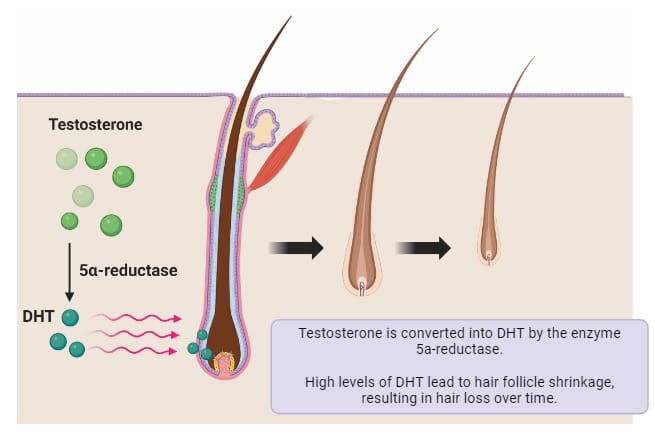Quick Summary: Does Testosterone Replacement Therapy (TRT) Cause Hair Loss?
Testosterone Replacement Therapy (TRT) has become popular as a solution for men who experience symptoms of low testosterone levels.
Although TRT provides significant benefits (e.g., increased energy, improved libido, enhanced muscle mass), it also raises concerns about potential side effects, especially hair loss [1].
Understanding the relationship between TRT, dihydrotestosterone (DHT), and male pattern baldness (androgenic alopecia) is essential for men considering this therapy.
What is Testosterone Replacement Therapy (TRT)?
TRT is a medical treatment that increases testosterone levels in individuals with low levels of this hormone. It can be administered through injections, patches, gels, and oral medications.
Low testosterone can cause symptoms such as:
- Reduced libido.
- Erectile dysfunction.
- Decreased bone density.
- Increased body fat.
- Fatigue and depression.
Studies found that testosterone levels decrease by approximately 1–2% every year after the age of 30 [2]. TRT counteracts this phenomenon and restores vitality, which addresses related symptoms of testosterone deficiency. TRT is commonly also associated with weight- lifting- as it helps to enhance recovery and promote muscle growth.
However, before starting it is important to consult a qualified healthcare provider to evaluate the underlying causes of low testosterone and determine whether TRT is appropriate. In fact, some men may require alternative treatments or a combination of therapies to achieve optimal results.
The Hair Growth Cycle and DHT’s Role
Hair growth occurs in three phases:
- Anagen (growth phase) – Active hair production that lasts for several years.
- Catagen (transition phase) – Hair growth slows down for a few weeks.
- Telogen (resting phase) – Hair sheds. Also, the follicle prepares for new growth over several months.

Dihydrotestosterone (DHT) is a byproduct of testosterone metabolism. It is produced when the enzyme 5-alpha reductase converts testosterone into DHT. Individuals with a genetic predisposition to androgenic alopecia (male pattern hair loss) have hair follicles that are sensitive to DHT in their hairline, temples or crown.

This sensitivity causes follicles to shrink, which precipitates thinner hair and hair loss [3]. Over time, the repeated exposure of sensitive follicles to DHT can result in complete hair loss.
For many men, androgenic alopecia manifests as a receding hairline or thinning at the crown. The pattern and severity of hair loss can vary widely. It is influenced by genetic and hormonal factors. Women may also experience hair thinning. However, it usually presents as a more diffuse loss across the scalp.
Does TRT Cause Hair Loss?
TRT increases testosterone levels, which can in turn elevate DHT levels. However, studies indicate that the main factor that influences hair loss is not the absolute level of DHT but the sensitivity of hair follicles to DHT [4]. Men without a genetic predisposition to androgenic alopecia are less likely to experience hair loss even if DHT levels rise with the use of TRT.
Here’s what research tells us:
A study conducted on transgender men who received TRT revealed that 5–17% of participants experienced mild hair loss within the first year [5].
Additionally, various studies found no direct link between high testosterone levels and male pattern baldness. Instead, these studies emphasised the role of follicular sensitivity to DHT [6].
More research suggests that androgenic alopecia is polygenic. In other words, multiple genes contribute to the condition [7]. This complexity underscores the importance of personalised approaches to the diagnosis and treatment of hair loss.
The Management of Hair Loss During TRT
DHT Blockers
- Finasteride – Reduces DHT production by 70–90%.
- Dutasteride – More potent. It reduces DHT by up to 99%.
These medications inhibit the enzyme 5-alpha reductase, which is responsible for the conversion of testosterone into DHT. The decrease in DHT levels can slow or even halt hair loss in men who take TRT. It is critical to consult with a healthcare provider before you start these treatments. Keep in mind that these drugs have side effects, including decreased libido and hormonal dysfunction.
Minoxidil
Minoxidil is a medication that promotes hair growth. It is effective in the early stages of hair thinning and works by prolonging the growing phase of a hair growth cycle. You can find this drug as a topical solution or foam as well as a tablet, which makes it a convenient option.
Natural Remedies
- Rosemary oil – This oil has effects that are similar to minoxidil in the promotion of hair growth [8].
- Caffeine shampoos – May counteract DHT at the scalp level.
- Nutritional supplements – Address deficiencies in zinc, biotin, and vitamins C, Vitamin D, and E.
These alternatives can be appealing to individuals who want a more natural solution rather than pharmaceutical solutions. Although their efficacy may vary, they have minimal side effects, so it doesn’t hurt to try them.
This table compares different hair loss management strategies:
| Treatment Type | Effectiveness | Mechanism |
| Finasteride | 70–90% | Inhibits 5-alpha reductase enzyme. |
| Dutasteride | 99% | Blocks DHT production almost completely. |
| Minoxidil | Moderate | Enhances scalp blood flow and follicle health. |
| Rosemary Oil | Moderate | Promotes follicular activity naturally. |
| Nutritional Supplements | Variable | Addresses underlying deficiencies. |
Hair Transplantation
Methods such as Follicular Unit Excision (FUE) and Follicular Unit Transplantation (FUT) relocate healthy follicles to areas of thinning.
Hair transplantation is considered a permanent solution for individuals with advanced hair loss. The redistribution of hair from donor sites at the back or sides of the scalp provides natural-looking results.
Low-Level Laser Therapy (LLLT)
LLLT stimulates hair follicles to increase density and slow hair loss. Devices such as laser caps or combs emit light at specific wavelengths to promote cellular activity within hair follicles.
Clinical studies have demonstrated their efficacy in the improvement of hair thickness and density, which makes them a valuable adjunct to other treatments.
Factors to Consider Before You Start TRT
Consult with specialists – Speak with both endocrinologists and trichologists to weigh the benefits and risks.
DHT testing – Blood tests can measure DHT levels to assess the risk of hair loss.
Family history – Examine genetic predispositions to androgenic alopecia (male pattern baldness or female pattern baldness).
Lifestyle measures – Consider managing other contributors to hair loss, such as stress, poor nutrition, and smoking before you initiate TRT.
Conclusion
Although TRT may contribute to hair loss in individuals with a genetic predisposition to androgenetic alopecia, it is not a direct cause of hair loss. The role of DHT sensitivity is more important. For those who undergo TRT, combining treatment with hair loss prevention strategies, such as DHT blockers, minoxidil, and natural remedies, can help mitigate potential hair thinning.
Get in Touch
Curious about FUE hair transplant solutions? Secure your no-obligation call with our London hair transplant clinic, or head to our FUE hair transplant clinic in Bristol. We’re also proud to support patients in Oxford and Brighton.
Our award-winning team, including leading London hair transplant surgeons Dr Fernando and Dr Vara, is here to support you every step of the way.
References
1-Bassil, N., Alkaade, S., & Morley, J. E. (2009). The benefits and risks of testosterone replacement therapy: a review. Therapeutics and clinical risk management, 5(3), 427–448. https://doi.org/10.2147/tcrm.s3025
2- Brawer M. K. (2004). Testosterone replacement in men with andropause: an overview. Reviews in urology, 6 Suppl 6(Suppl 6), S9–S15.
3- Chen, X., Liu, B., Li, Y., Han, L., Tang, X., Deng, W., Lai, W., & Wan, M. (2020). Dihydrotestosterone Regulates Hair Growth Through the Wnt/β-Catenin Pathway in C57BL/6 Mice and In Vitro Organ Culture. Frontiers in pharmacology, 10, 1528. https://doi.org/10.3389/fphar.2019.01528
4- Ustuner E. T. (2013). Cause of androgenic alopecia: crux of the matter. Plastic and reconstructive surgery. Global open, 1(7), e64. https://doi.org/10.1097/GOX.0000000000000005
5- Thoreson, N., Grasso, C., Potter, J., King, D. S., Peebles, J. K., & Dommasch, E. D. (2021). Incidence and Factors Associated With Androgenetic Alopecia Among Transgender and Gender-Diverse Patients Treated With Masculinizing Hormone Therapy. JAMA dermatology, 157(3), 348–349. https://doi.org/10.1001/jamadermatol.2020.5475
6- Tawanwongsri, W., Desai, D. D., Nohria, A., Shapiro, J., & Lo Sicco, K. I. Hair loss in athletic testosterone use in males: a narrative review. International Journal of Dermatology.
7- Heilmann, S., Brockschmidt, F. F., Hillmer, A. M., Hanneken, S., Eigelshoven, S., Ludwig, K. U., Herold, C., Mangold, E., Becker, T., Kruse, R., Knapp, M., & Nöthen, M. M. (2013). Evidence for a polygenic contribution to androgenetic alopecia. The British journal of dermatology, 169(4), 927–930. https://doi.org/10.1111/bjd.12443
8- de Macedo, L. M., Santos, É. M. D., Militão, L., Tundisi, L. L., Ataide, J. A., Souto, E. B., & Mazzola, P. G. (2020). Rosemary (Rosmarinus officinalis L., syn Salvia rosmarinus Spenn.) and Its Topical Applications: A Review. Plants (Basel, Switzerland), 9(5), 651. https://doi.org/10.3390/plants9050651
Share:
Authored by
Reviewed by
Book a Consultation
Related Blogs
Unlocking the Secrets of Anagen Follicles
October 23, 2025
Have you ever glanced at a mirror and wondered why some of your hair grows fast and…
Does Finasteride Cause Erectile Dysfunction?
October 22, 2025
Finasteride is one of the most promising medicines against male pattern baldness and benign prostatic hyperplasia (BPH)….
What Happens If You Stop Using Minoxidil
October 8, 2025
So, you’ve been faithfully rubbing Minoxidil into your scalp like a love potion for your hair, and…
Zinc Supplements After Hair Transplant Surgery: What You Need to Know
October 7, 2025
Zinc is an essential nutrient in wound healing, tissue repair, and the healthy development of hair follicles….
What to Eat After a Hair Transplant: Essential Nutritional Guide
October 5, 2025
After the stress, needles, and surgeries, food becomes more than nourishment. A warm bite, a familiar flavour,…
Hair Loss Treatment That Works: A Complete Guide for 2025
October 3, 2025
Millions of men, women, and teenagers have hair loss problems. In 2025, hair restoration is going through…
What is an FUE Hair Transplant?: A Comprehensive Guide to Procedure, Recovery, and Results
October 3, 2025
Hair transplant surgery has gained popularity over the years, with more people now comfortable taking care of…
Does Omega-3 Deficiency Cause Hair Loss? Evidence, Mechanisms & Nutrition Guide
September 16, 2025
Omega is an essential fatty acid required for a healthy body, skin and scalp. Modern-day diets are…
When Can You Use Nizoral After a Hair Transplant?
September 12, 2025
Nizoral is a medicated shampoo that contains the antifungal drug ketoconazole. This shampoo acts against fungal infections…










